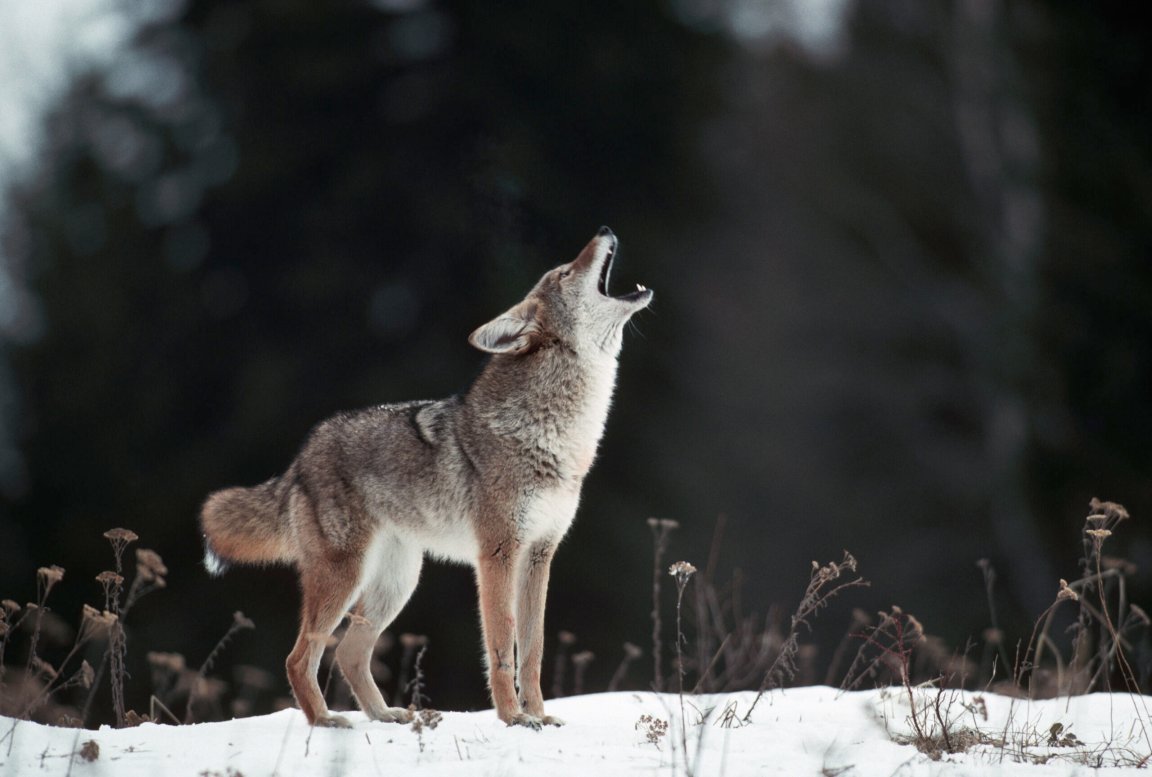Thanks to the prevalence of electronic calling devices, anyone can become a decent coyote caller with the press of a few buttons. But if you really want to step up your game, you need to first understand what makes coyotes tick. Coyote behavior changes throughout the winter and through their breeding period. Understanding exactly what the different sounds mean to the coyotes you’re calling will make you more effective.
So don’t just start pressing random buttons on your e-caller. Follow these expert tips and strategies on how to call coyotes.
Types of Coyote Calls
Prey Distress
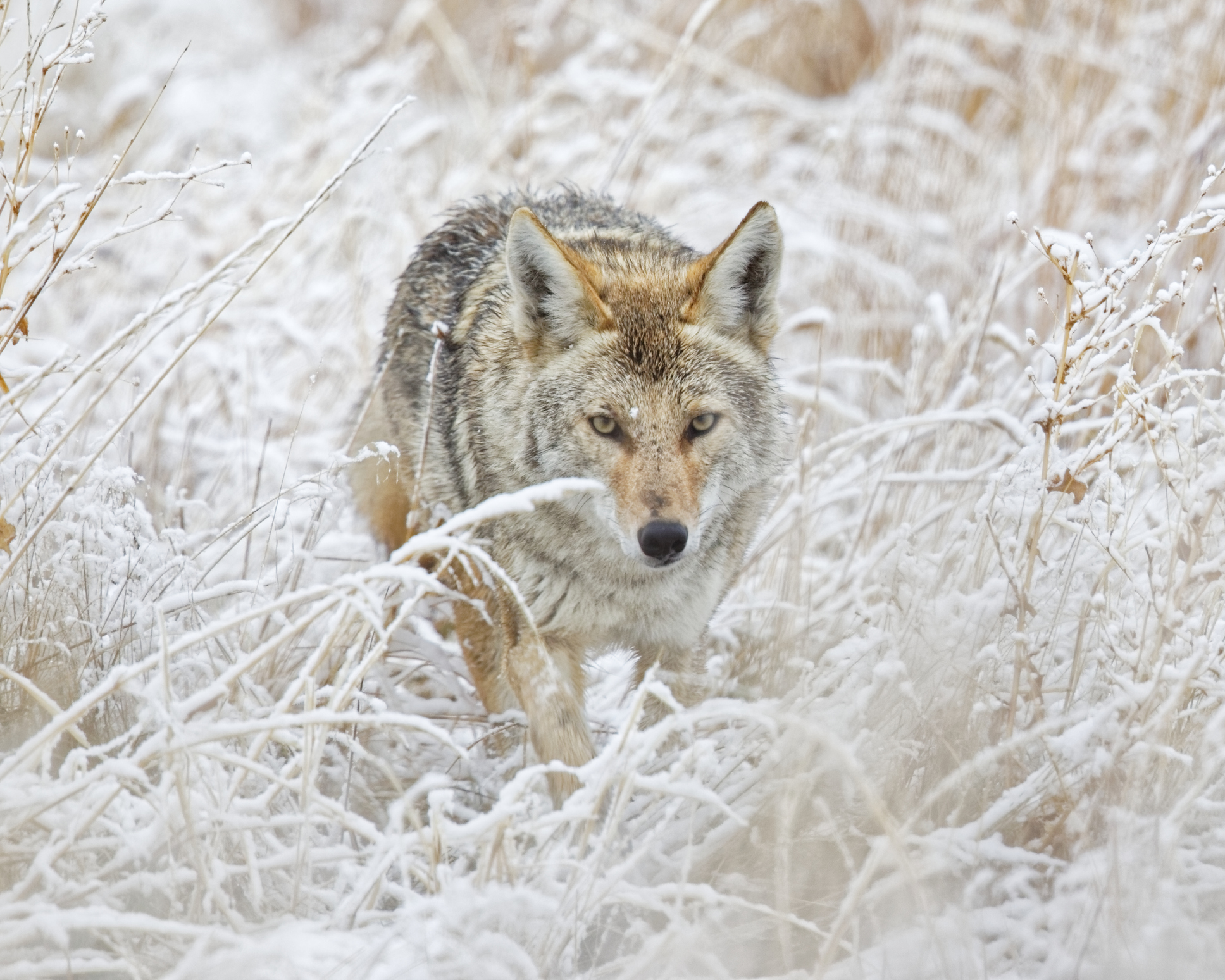
Coyotes are nature’s great omnivores. Studies of stomach contents have found that coyotes will swallow almost anything that they can get in their mouths, including rocks, plastic packaging, harness buckles, and even the occasional rabbit. Knowing this, it doesn’t matter much which sort of prey distress call you use–most modern electronic callers offer everything from a whitetail fawn to a house cat–as long as you set up within a coyote’s earshot.
The manner in which a coyote approaches a distress call depends on its security level, which is influenced by its latest experiences. An unpressured coyote will often come in quickly and boldly to almost any distress sound. A pressured coyote, however, will take much longer to approach a call. He’ll wait downwind of the coyote howl before slowly slinking in, wary nose to the air.
In 2005, a predator-research biologist gifted me with a major opportunity when he invited me to call coyotes for him at the Idaho National Laboratory research area, where he was studying a large number of GPS-collared coyotes. Every six weeks the coyotes were trapped, whereupon their collars were fitted with fresh batteries, and the tracking information in them was downloaded and reproduced in a computer animation. These dogs were extremely pressured.
Upon hearing the initial prey distress cries, the test coyotes would usually run to a downwind position without exposing themselves and remain there until we left. They would later approach our stand area to investigate. One wary old alpha pair (the male was 10 years old) waited 17 hours before approaching the calling location, and then spent 45 minutes at our stand site sniffing around.
The takeaway? One of the biggest mistakes you can make with a distress call is leaving a location too soon. Spend at least 30 to 45 minutes on stand.
Another important factor is the time of day you target coyotes. Only 10 percent of respondents in a recent poll of about 1,400 coyote callers said dawn was best. More than half the hunters chose 8 a.m. to 10 a.m., followed by 11 a.m. to 2 p.m., and then dusk, each of which got about 20 percent of the vote.
Expert Opinion: Les Johnson
Les Johnson is perhaps the best coyote caller in the country, and he relies entirely on prey distress calls. He prefers the half hour just before dark.
“I think predators that have been laid up all day and maybe didn’t have a chance to fill their belly during the previous night’s hunting might be willing to come investigate my sounds as darkness falls,” he says. “Darkness is a huge safety net for a predator.” Johnson has developed his own line of open-reed and closed-reed hand calls, and uses a wide variety of distress sounds depending on his setup. His go-to call is the long-range Ruffidawg jackrabbit distress call.
READ NEXT: Best Coyote Calls
Whines and Yelps
These nonaggressive vocalizations–often made by pups–are probably the most effective sounds in a coyote caller’s repertoire because they trip so many behavioral triggers at once. With the press of a button you can target social interaction, territorial instincts, and protective maternal/paternal instincts. At certain times of the year, a case could probably be made that you’re appealing to their hunger, too, since several studies have documented coyotes cannibalizing pups.
My son Tyler and I use whines and yelps on almost every single stand. During denning season (March through May), when family bonds are strongest, it is the most reliable sound you can use. But these sounds are just as effective during the recovery and mating seasons, approximately September through January, when the puppies have grown, family bonds are more relaxed, and the group is less cohesive.
One of the most aggressive approaches we have witnessed was from a coyote that began bark-howling at Tyler’s puppy yelps as soon as he began the series. The coyote came in from 80 yards back in the brush with the hackles on his shoulders and hips raised, barking so hard that his feet bounced off the ground.
Before switching to a different sound, we’ll increase the volume and intensity of the whines and yelps for three or four series in order to reach out to distant coyotes. This has proven extremely effective in all seasons and geographic locations, and at any time of day.
Expert Opinion: Gerald Stewart
Coyote call guru Gerald Stewart suggests adding more elements to your setup when using whines and yelps to reel a coyote in close. “You’ll get a coyote to fully commit if you add an attractant scent for his nose and a moving decoy for his eyes,” Stewart says. “But don’t overdo it with these other tactics, because an educated coyote will catch on to them quickly.” Stewart also says to diversify your calling with howls, yelps, and distress calls to bring coyotes running in.
Challenge Howl
The challenge howl is a misnomer. A challenge is an invitation to fight, to do battle, such as a monarch bull elk bugling at a satellite bull. Coyotes don’t do that. Biologists call this vocalization the threat-bark howl because it more accurately describes the intent of the coyote: to threaten and demand that the intruder leave. Now. Field observations have shown that coyotes (unlike wolves) will avoid fights whenever possible. A wolf pack will run down an intruder and kill it. A pack of coyotes will run down an intruder, make him submit, and then let him leave the territory.
For these reasons, callers should use this vocalization only if they know they are set up in a pack’s core territory. If a caller sets up near a den during whelping or denning season, the results can be spectacular. Having resident coyotes charge in on a close, loud, aggressive call rivals any approach of a rutting buck or strut of a spring gobbler. However, if you set up in overlapping home ranges and demand that every coyote within hearing distance leave, they probably will.
The key to locating a pack’s core area is to home in on their group-yip howls. Listen for a pack’s group howl night after night. If you are able to pattern their howling with some regularity, you should be able to determine their core area. Once you’ve plotted that on a map or GPS, study the terrain. Coyotes will typically hide out in the thickest, most secluded cover in the area. Make an educated guess and move in close before threatening the pack.
Many callers will break off a stand when a coyote bark-threat howls in response to their distress calls because they believe that it means the coyote has busted them and will not approach. That’s not always the case. The coyote may simply be protesting the source of the sound even if it hasn’t identified it. You can often get a barking, threat-howling coyote to expose himself for a clear shot if you wait him out and weaken your return howls, keeping them less aggressive than the coyote’s. Another tactic is to retrace your steps and then circle around to a different location. If the coyote doesn’t see or scent you, you can call him in to the new setup with whines and whimpers.
Group and Solo Howls
Coyote calling is a numbers game. You want to offer sounds that appeal to the largest number of coyotes without alarming or intimidating them. During 54 years of howling at coyotes across 22 states and Mexico, I’ve found that the most effective howl to draw them in is a lone howl that is low frequency, high pitched, and long. It announces the presence of an unknown, young, small, nonaggressive coyote that any other dog within hearing distance will be willing to investigate.
Louder, long-range howls are more likely to get howls in return, but they are less likely to draw a coyote in to your stand.
Knowing that, here’s a simple formula for success: Locate coyotes with a group-yip howl (the collective yowling that you have undoubtedly heard on calm evenings) and call them in to gun range with a lone howl.
Here’s why it works. In a Utah State University study, researchers recorded coyote barks and howls and analyzed them with a spectrograph. They found highly specific information encoded in coyote howls, including identity, sex, size, age, and even emotional state. Researcher Dr. Philip Lehner identified and described 11 coyote vocalizations, and he listed them in three categories: 1) contact: long-range howls; 2) greeting: whines, yelps, and low-frequency howls; 3) agonistic: warning and alarm vocalizations.
Most of those vocalizations are aggressive in nature. This is important to know because such vocalizations will alarm and/or intimidate most coyotes. Submissive coyotes will often retreat to their core areas after howls are broadcast and remain there until joined by another group member or until enough time has passed for them to call back or investigate. That’s the exact opposite of what you want your howls to do.
It is important to remember that coyotes will sometimes investigate the source of your group-yip howls, so don’t get caught unprepared.
Expert Opinion: Al Morris and Garvin Young
Al Morris and his partner, Garvin Young, are the only three-time winners of the World Coyote Calling Championship. Morris’ key to success in the field is mixing up howling, distress calls, and yelps all during one set.
“In the last three years, I have doubled my success by starting with a howl, then using some prey distress, or using strictly howling with aggressive and nonaggressive coyote vocalizations,” Morris says. “I think if you’re not using a hybrid system, you’re only going to kill 25 percent of the coyotes you’re calling to.” ––Rich Higgins
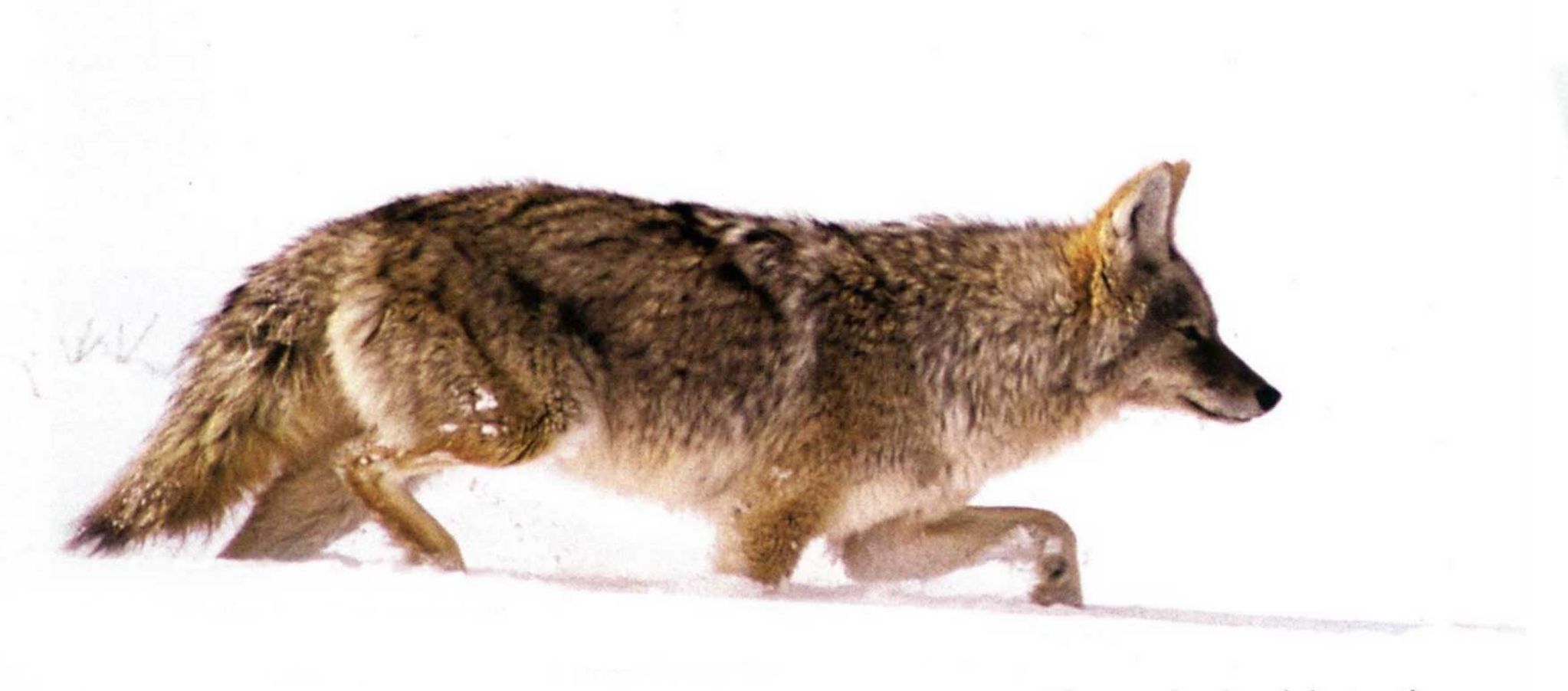
Coyote Calling Tips and Tactics
Native American mythology doesn’t call the coyote a “trickster” for nothing. In areas with substantial hunting pressure, coyotes learn very quickly that humans can scream as agonizingly as tiny mammals in the throes of death. So they circle into the wind, bark warnings to their brethren and leave eager hunters waiting in the cold. To keep you one trick ahead of these cagey canines, we’ve found some cutting-edge hunting tactics the coyotes in your neighborhood might not be privy to.
READ NEXT: How to Hunt Coyotes
Call Coyotes at Night
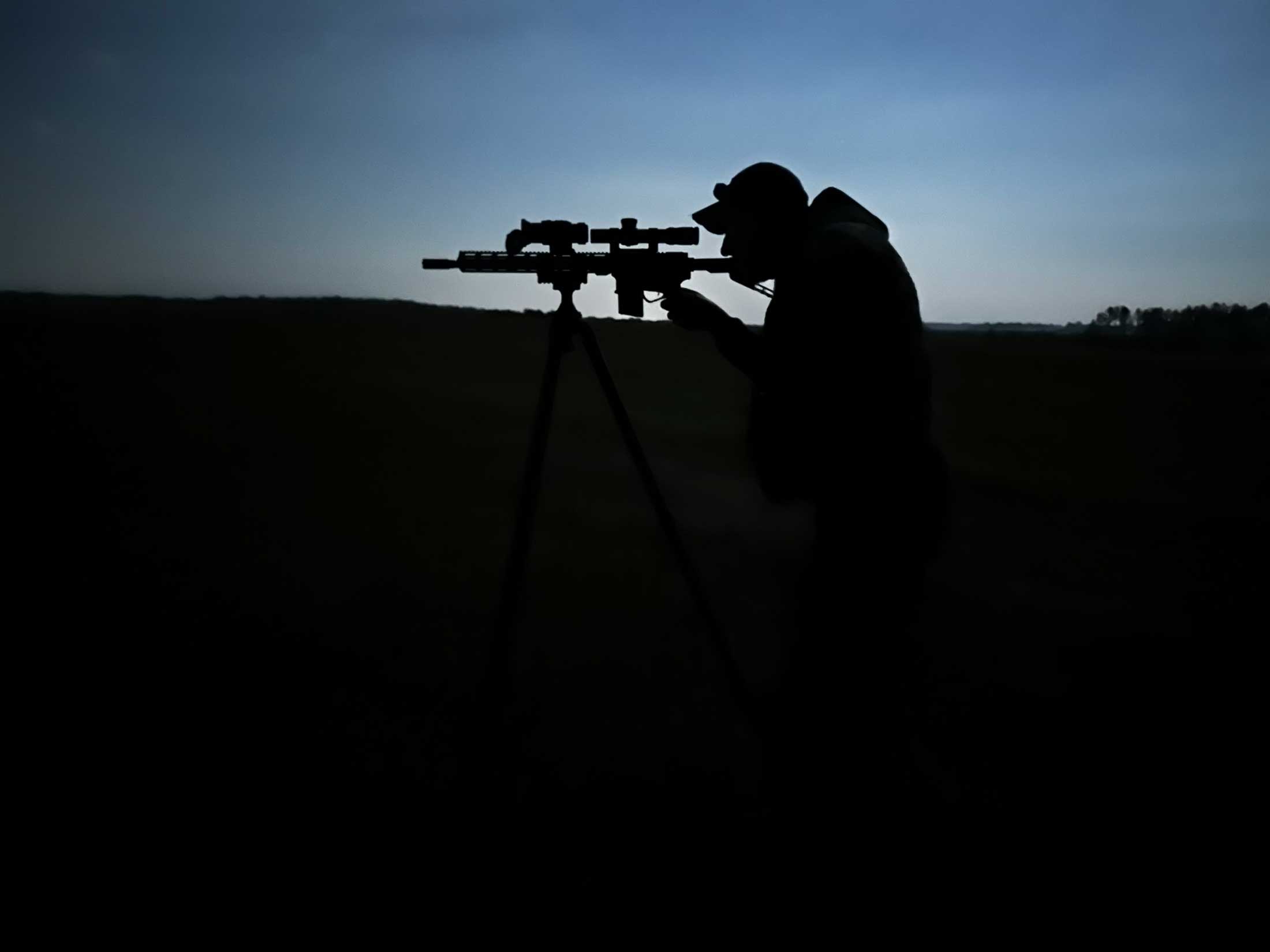
In a lot of places hunting coyotes at night is more popular than pursuing them during the day. Of course, make sure to check your local regulations before planning a nighttime hunt.
Armed with a good thermal monocular and thermal scope, you’ll be able to target coyotes after dark when they are most active. Coyotes are more vocal at night and you’ll be able to hear them howling from a long distance on a calm night. Importantly, coyotes tend to be less wary under the cover of darkness, and will come in to calls more aggressively. You’ll still have to factor in the wind, but it’s not as important to establish a perfect hide when hunting at night. This allows you to hit more spots more quickly.
Start a Territorial Dispute
I didn’t start the barking match, but it looked like I was going to have to end it. Apparently my howls had irritated a coyote, but instead of charging in, it stopped every few minutes to bark aggressively at me like a German shepherd defending its yard. Most coyote hunters would walk away from such an obvious dead-end situation. A barking coyote, after all, is an alarmed coyote. But the bark didn’t sound right, so I decided to stick around and test this coyote’s patience.
To irritate it into an encounter, I barked back, mimicking its nasty tone. The dialogue didn’t push the coyote into hyperdrive, but the animal’s pace did pick up. Fifteen minutes later it dropped into a gully and I scrambled out to a point to set up prone for the shot. At 100 yards the coyote emerged and started its irritating barking again. Tired of the talk, I ended the conversation with a single shot from my Remington, chambered with the coyote’s worst enemy, the .22/250.
After two decades of chasing after coyotes, I’ve never had one bark at me as incessantly as that old male, but my change in calling tactics turned a questionable encounter into the acquisition of a prime pelt.In most of the country coyotes no longer roll over for the off-the-shelf dying rabbit calls like their predecessors did. If you vary your tactics and mix up your calls, more coyotes will end up in your truck. Plus, if you do miss an opportunity, you can revisit that site later, using a different style for a storybook ending.
So when a coyote barks, bark back. This is especially effective in late winter and early spring, when coyotes have staked out territories. A dominant male will protect the area near his den from other rivals.
Livestock Leads to Coyotes
Coyotes inhabit all reaches of North America, but they are not evenly distributed. As is the case with people, they are attracted by certain types of habitat. Land with livestock, especially cattle and sheep, is prime coyote country. If you can pinpoint livestock populations in your area, your search for coyotes might be over. Most hunters are familiar with the hatred livestock owners, especially sheep owners, feel toward coyotes.
According to past studies by the U.S. Fish and Wildlife Service, nearly 70 percent of sheep ranchers report no loss of adult sheep, but at least 1 in 10 ranchers report lamb loss of 20 percent or more. One seven-month study on a Montana ranch documented a loss of 330 lambs and 33 ewes-17.8 percent of the sheep in all.
Cattle are big enough to fend off aggressive coyotes in most situations. But that doesn’t mean coyotes don’t hang in their neighborhood, says 25-year coyote veteran Larry Symes.
Symes, an equine dentist from Eufaula, Okla., hunts coyotes for six months of the year. “I learned to focus on cattle from a pilot in Texas,” recalls Symes. “He didn’t hunt coyotes, but he was the helicopter pilot for Wildlife Services [BRACKET “a division of the Department of Agriculture that deals with problem wildlife”] and I learned firsthand from him that livestock-rich areas have high densities of coyotes.”
During winter and early spring, coyotes hang close to livestock waiting for the opportunity to prey on newborns or gorge on the occasional female that dies giving birth. “Coyotes are like vacuums,” says Symes. “They feed on the placentas and afterbirth left behind by a cow that has given birth and they eat newborn calf manure. For about the first two weeks of a calf’s life, its manure is rich in milk and has a chalky appearance. Being opportunists, coyotes clean it up.”
In Symes’ opinion, a coyote congregation around livestock has pluses and minuses. The obvious plus is the high concentrations. Using the right call, you should find success quickly. But therein lies the minus. Calling in an area that has a lot of coyotes might result in several coyotes coming in at the same time. A lone hunter can handle one or two coyotes, but when four or more come to a call, some of the predators will inevitably get away. If possible, hunt with a partner to reduce the chance that coyotes will escape.
When hunting around livestock, it’s wise to stay at least half a mile away from the animals, because cows with calves might approach a distress call. Symes likes to test his call’s carrying ability on distant cows. If the cows lift their head and look his way when he calls, he knows coyotes will be able to hear it from much farther away.
Hunt Coyotes With Your Dog
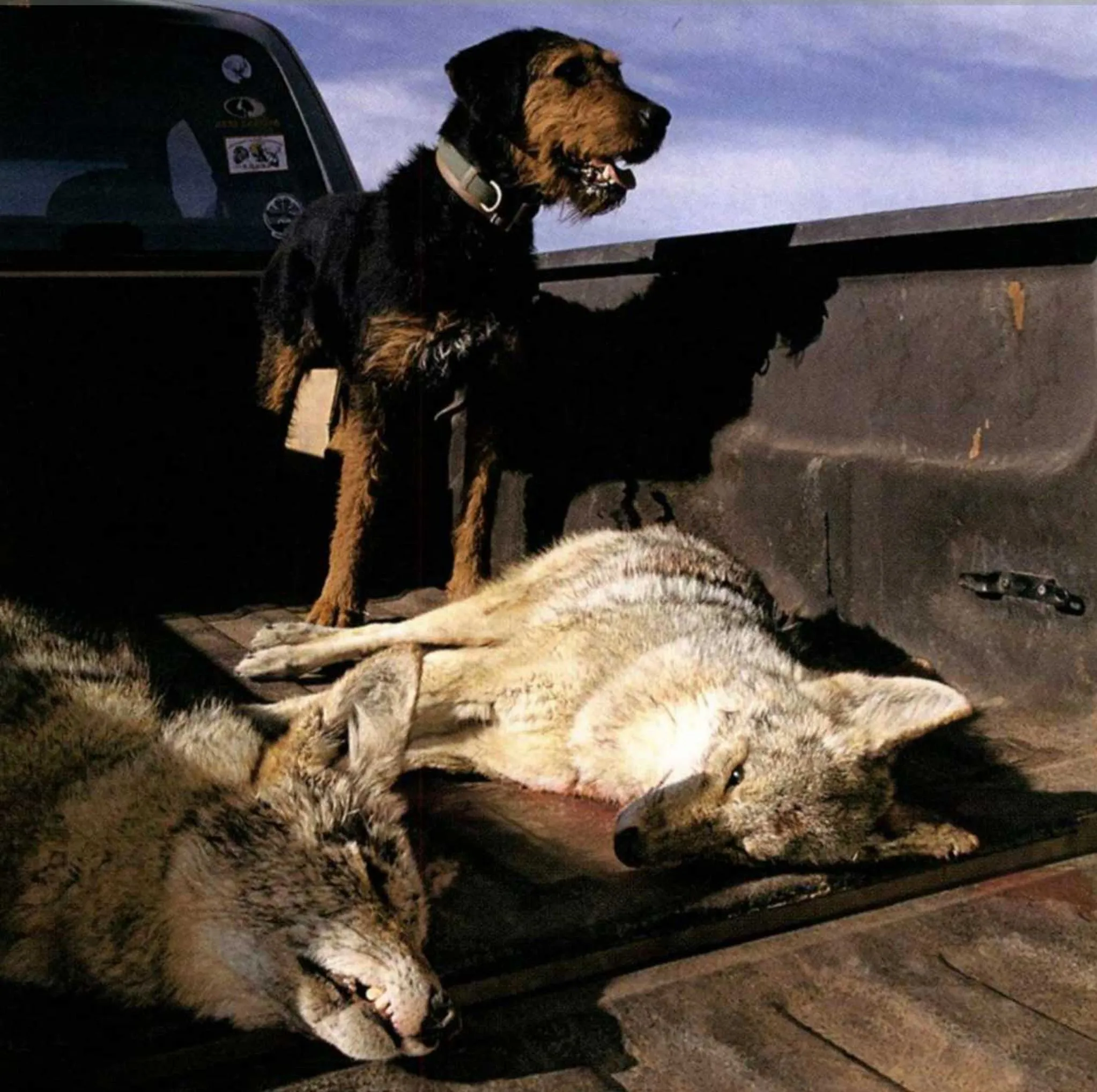
Throughout history, dogs have performed numerous tasks. They’ve had duties as varied as guarding, packing, rescuing, pulling, herding, guiding blind people and, of course, hunting.
Open the kennel and invite your pooch to make personal history for you. Take it coyote hunting. If you’re an avid coyote hunter, you’ve probably heard of people using dogs as decoys. Although the best dogs have been trained to work coyotes aggressively, your dog’s presence while you’re on a stand might be just enough enticement to lure an animal in for a shot.
I became a believer in using dogs after an early March experience while walking a pair of golden retrievers. A friend of mine was out of town and asked me to pick up his dogs at the local kennel and take them for walks whenever possible. I picked them up and drove to a nearby ranch to look for shed whitetail antlers. Unexpectedly, we surprised two coyotes loafing in a gully. Instead of retreating, the coyotes zeroed in on the dogs and wouldn’t leave. Had I been toting my .22/250, I would have had a slam-dunk 150-yard shot.
Merv Griswold, a coyote expert from Gillette, Wyo., has been using dogs to lure coyotes in close for a dozen years. With 40 years of coyote-hunting experience backing him up, Griswold is completely sold on the effectiveness of drawing coyotes out with dogs.
“I’ve literally gotten up and walked to get a better shooting position in full view of coyotes that were watching my dogs, and the coyotes still came in,” Griswold recalls. “Things like that will happen to you when you’re using dogs. Once the coyote comes in contact with a dog, its entire focus is on that dog.”
Griswold has used everything from a German shorthaired pointer to an Airedale crossed with a Jack Russell terrier to hunt coyotes with. His current breed of choice is the mountain cur, but that doesn’t mean the dog in your kennel won’t work.
“Breed doesn’t matter and size isn’t crucial, but ideally you want a dog that isn’t bigger than a coyote. If you use a huge dog, it might be too intimidating,” states Griswold. “When we’ve used two dogs together, the coyote goes after the smaller dog every time.”
Use a dog that you’re confident can outpace a coyote. If not, you might have a tough time explaining why your spouse’s Chihuahua didn’t make it back from the hunt. Well-trained dogs with a strong sense of loyalty to their owners are best.
“If you decide to use your dog, practice commands and have it return to you while you’re lying in the grass,” stresses Griswold. “Don’t let a dog go out too far, either. You want it to stay close like a bird dog. Most dogs pick up the routine quickly and automatically come back, especially if a coyote begins to trail them.”
Sitting high on a ridge downwind from where you expect coyotes to be, command your dog to hunt the territory in front of you and then use a series of howls to gain the attention of area coyotes. Once a coyote catches sight of your dog, it will either chase it or slink in for a closer look. During the breeding season in February and March, male coyotes are very protective of their territory, but during the rest of the year, a coyote’s attitude will determine how it reacts to the invading dog. If a coyote follows your dog, call your dog back, though more than likely your dog will automatically return to you with the coyote following behind.

Talk Dirty
Dave Tatum, who lives and hunts coyotes in South Dakota, is a former animal-control officer. Today Tatum manages a hunting lodge in north-central South Dakota, where he pursues coyotes at every opportunity.
Tatum picked up on trash talk while watching a pair of coyotes during breeding season (generally January through March across the nation).
An old male was courting a young female. The female whimpered and whined throughout the encounter. Soon after witnessing this scene, Tatum went hunting with Randy Anderson, a coyote hunter with a knack for capturing his hunts on video. Anderson had heard similar vocalizations from female coyotes. The two hunters shared their experiences and then decided to turn them into a new late-winter tactic.
Tatum rarely uses a distress call once breeding season begins. Instead, he focuses on imitating a receptive female with the sounds he heard. He describes the call this way: “It’s almost like the hurt whimper call most hunters use to try to stop an escaping coyote. But instead of sounding like a coyote in pain, it has a higher pitch and sounds more submissive. Some house dogs make a similar sound when they greet their master.”
Tatum will occasionally toss in a few male howls with the female whimpers. Instead of making the howls sound dominant, he believes it’s best to tone the aggressiveness down a notch. He uses a higher pitch with a hint of uncertainty instead of sounding deep and coarse, since he doesn’t want to intimidate any male coyotes that might be in the area.
When incorporating this call into setups, Tatum doesn’t include any distress calls-coyotes, especially males, are preoccupied with finding a mate. He waits 30 or 40 minutes before calling it quits. If feasible, he’ll pack along a decoy. Commercially made coyote decoys are as hard to come by as card-carrying animal-rights ranchers. A quick fix is to take your next coyote to a local taxidermist and have him cheaply stretch the hide over a coyote form. ––Mark Kayser
Read Next: Best Coyote Calibers
Final Thoughts on Calling Coyotes
Calling coyotes can be as complicated or as simple as you want to make it. No matter what calling strategy you decide to use, make sure you’re set up in a way that you’ll be able to see coyotes attempting to circle downwind of you. Also, always be ready to shoot. Coyotes can charge a setup quickly, and they can leave just as quickly. These crafty critters rarely stand still for long.
